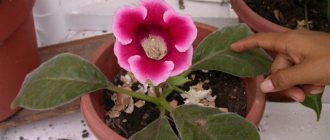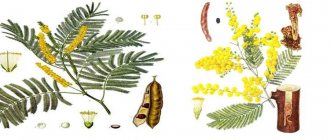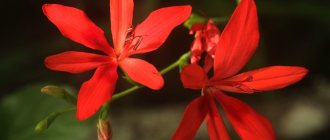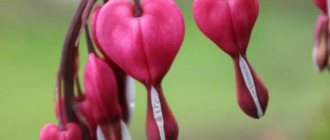Homeland of the plant
Croton is a spectacular and colorful representative of wild plants growing in the Pacific Islands, northern Australia, southeast Asia and India. Today there are more than 1000 varieties of wild plants.
As an indoor flower, amateur gardeners grow only one subspecies - the variegated croton, as well as its artificially bred hybrid counterparts. “Joseph's Cloak” is one of the most spectacular and beautiful representatives among ornamental plants. Such a flower will decorate any interior of an apartment, house or office, and will delight the owner’s eyes for many years.
Reference! In ancient times, croton was considered a talisman against evil spirits, the evil eye and negative energy; it was also endowed with the properties of preserving family ties and maintaining “fire” in the hearth.
Pruning and replanting
For young plants, replanting should be done annually; for older shrubs, the procedure is carried out as the roots fill the pot. The container should be chosen wide with low sides, not exceeding four centimeters in diameter from the previous “place of residence”.
Pruning is done if it is necessary to form a bush of the desired shape. To do this, the crown is cut off at a distance of about a quarter meter from the top of the plant, and the side leaves (old or damaged) are cropped. Over time, the flower will begin to branch out and take on a rather attractive appearance.
Advice: do not throw away the top after cutting; it can be used as material for growing a new specimen.
Types with photos and descriptions
Only variegated croton is grown indoors. Its peculiarity is the ability to change the color and shape of the leaf plates depending on the conditions in which it grows and develops. In the wild, this plant can be observed live in Pakistan and China.
The shrub can reach more than three meters in height; the stem has wide, flat leaves of different colors, which range from brown to green. The main varieties of croton:
Mrs Eyeston

In the wild, it is a tall shrub or tree with a rich burgundy trunk of a bright shade; the leaf plates have many bright spots of pink shades. There is another variety of plant - its leaves are bright yellow and have black spots on the surface.
Petra
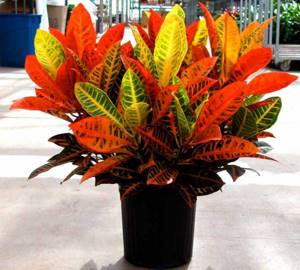
In natural conditions, Petra's croton reaches a length of more than four meters, has a beautiful crown, many branches, and a varied shape of leaf blades (sharp, lobed or oval). The color of the leaves is a rich emerald color with a bright yellow stripe along the edge of the leaf blade, and spots along the entire surface of the same color.
Black Prince

The most striking and unusual representative of the Euphorbiaceae family. Its appearance resembles a festive fireworks display. The leaf blades are flat, very wide, oval in shape. Each leaf has veins and large patches of bright red, yellow and orange colors.
Disraeli
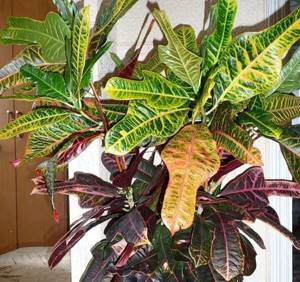
Disraeli differs from its counterparts in the lobed shape of the leaf plate. The leaves are deep green on top, with veins and splashes of deep yellow. Under the leaves you can see a rich burgundy shade and small yellow splashes.
Fertilizer and feeding of croton
The flower is fed from April to November. To do this, use complex mineral fertilizers, which are placed on pre-moistened soil. The procedure is carried out twice a month, in winter – once a month.
The formation of a beautiful plant crown is achieved by pruning an adult flower and pinching a young one.
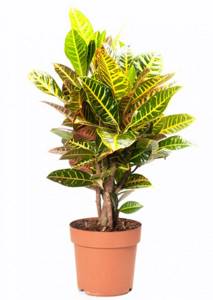
Young croton is pinched when its height has reached 15 cm, then as the shoots grow. It is advisable to remove the resulting flower stalks or buds, since defective flowering exhausts the plant.
Home care
When kept indoors and grown, variegated croton is one of the most demanding and difficult to care for ornamental plants.
Features of plant care:
- Remember that croton juice contains a highly toxic substance that can cause nausea, gag reflex, stomach upset or allergic reactions in the form of a rash all over the body. When performing any manipulations with the plant, wear gloves. If there are small children in the house, put the flower out of their reach.
Important! This plant loves high levels of humidity in the air. Make your plant happy by regularly spraying water from a spray bottle in close proximity to the flower. Every day, wipe the leaf blades with a clean cloth, moistening it in cool water. In the hot season, the plant needs a special procedure - a shower with warm water. This manipulation must be performed once a month.
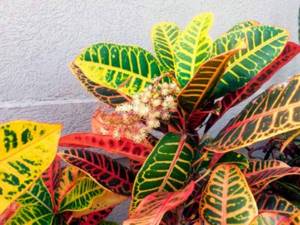
Do not allow drafts, sudden temperature changes, or hypothermia. It is necessary to water the flower exclusively with warm water. If these recommendations are not followed, the exotic plant will die.- During the flowering period, croton loses its attractiveness due to the appearance of the peduncles. The disadvantage of flowering is that it takes away the bulk of the plant’s energy for development and growth. If you do not plan to grow the plant from seeds, then keep an eye on the buds and flower stalks that may appear at any moment, and immediately carefully cut them off.
- Flower owners note that after the growing season, leaf blades can change color and shape. At the moment, the issue of such a phenomenon has not been studied deeply enough to explain its principle of action.
- Croton is one of the fastest growing plants. Thanks to this, many breeders were delighted and in a short period of time developed a large number of new hybrid plant species, differing only in the appearance and color of the leaf blades.
Illumination
Croton needs bright light , but direct sunlight will adversely affect the growth and development of the plant. In the warm season, the pot with the plant is placed on the north side; in the cold season, the flower is placed on the windowsill located in the southern part of the apartment.
Temperature
In summer, the temperature for good flower development should be from 21 to 23 degrees Celsius. In the cold season, the minimum acceptable scale threshold is not lower than 15 degrees.
Watering
The plant loves not only moist air, but also well-moistened soil, which should always be slightly wet. At the same time, the owner of an exotic flower must ensure that the plant does not float in water, otherwise its root system will begin to rot and the flower will die. Watering is carried out only with water at room temperature or higher . The water must be purified or settled.
Air humidity
For the full development and growth of a flower, a high level of air humidity is required. It must be constantly maintained with water, spraying it from a spray bottle or wiping the leaf plates from dust and dirt.
Transfer
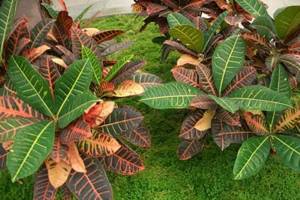
An adult plant is moved to another pot with new soil once a year. When buying a flower pot for croton, remember that its diameter should be 22 mm larger than the previous one.
Once the pot size reaches 25 cm, replanting should be stopped. Once a year, take the time to remove the topsoil and replace the substrate with a new one.
How to root?
To carry out the process of replanting croton, you need to purchase good soil designed specifically for such plants. You can make your own soil mixture at home. To do this, you will need to take equal proportions of river sand, peat sand, leaf and turf soil.
To root a flower, it must first be removed from the old soil. It is important and necessary to preserve the earthen ball on the root system of the plant. In a new pot, be sure to provide good drainage, which should occupy 25% of the contents in the pot.
Reproduction
Croton propagates by cuttings and seeds. Let's consider each method separately.
Leaf
Flower propagation can be done by cuttings. The cuttings located at the top take root and develop fastest. Its length should be at least 5-7 cm. If you need a large number of cuttings that can be planted and immersed in the process of growing exotics, divide 1 cutting into several equal parts.

Make sure that on each segment there remains an internode and one healthy leaf blade. After separating the shoot, rinse it well to remove toxic traces of juice. Then leave it to dry in the fresh air so that the cuts are not fresh.
At the top of the cutting, the leaves must be carefully cut into thirds, along a line parallel to the veins. The remaining leaves must be removed.
Treat the cut of the cutting with Kornevin, then place it in water at room temperature (make sure that the water is warm throughout the entire time), the optimal solution is to place the glass with the cutting on the radiator.
Remove the glass with the cutting from direct sunlight and wait until the white roots appear. When the roots reach a length of 0.2 cm, plant the cuttings in a pot with previously prepared soil. Monitor the soil moisture level and do not allow it to dry out.
From seeds
At home, the easiest way to plant croton is with its seeds. For successful cultivation, only freshly collected seeds are used. Remember that growing from seeds is a very labor-intensive and long process. Croton has fairly large seeds.
Before planting, they are placed in heated water for half an hour and left for a day for better swelling. Seeds are planted to a soil depth of 1 cm. After the sowing process is completed, remove the containers to a dark, warm place and wait for the sprouts to peck.
Reference! Watering is carried out only in a saucer, from which the plant itself will take the required amount of moisture. When the number of leaves on a sprout reaches three, they can be planted in separate small pots. Caring for sprouts is similar to caring for adult croton.
Pests and diseases
Pests are quite frequent guests in the life of croton. Pests such as:
- nematodes;
- spider mites;
- mealybugs;
- Scale insects.

The majority of croton owners, after unsuccessful attempts to get rid of mites, decide to simply throw the flower in the trash. At the same time, forgetting that croton, like any other living organism, needs proper care and attentive attention.
Pests appear in the plant only if the croton is treated negligently or the rules of care are neglected.
The most common causes of pests:
- Too frequent, infrequent watering, or its complete absence.
- Low level of air humidity.
- Negligence in wiping the leaves of the plant and the water procedures it needs.
In order to eliminate mealyworms, spider mites and scale insects from the soil and flower, a tobacco solution is used. It is mixed in equal proportions with soap, and the composition is wiped with platinum leaves and the stem of the bush. Be sure to wash off the applied solution from the above-ground parts of the croton after 1-1.5 hours after its application. Make sure that the soap-tobacco mixture does not get into the soil.
Proper care of croton
To ensure that your flower always delights with its magnificent appearance, take note of a few basic rules for caring for croton, presented below.
Croton is a light-loving plant, but most of all it prefers direct sunlight. The best place for a flower is a north window, where bright light predominates in the morning and before sunset.
If you have the opportunity to take the plant out into fresh air and diffused sunlight in the summer, then be sure to take advantage of it. The optimal temperature for a flower is 20-22 degrees in summer and not lower than 16 in winter.
Watering croton is carried out directly into the earthen ball. The soil should be constantly slightly moist, but water should not be allowed to stagnate in the roots, which can cause rot. Water for irrigation must first be filtered or settled.

In addition to timely watering, pay special attention to spraying and wiping the leaves with a damp sponge. In hot weather, give the plant a warm shower, but be careful not to get excess moisture into the pot.
Can I keep it at home?
In indoor conditions, only one variety of croton is allowed to be kept and grown, this is the Variegated Croton. If you love exotic and unusual plants, and are ready to invest a part of yourself in caring for them, this plant is just for you.
As a conclusion, it can be noted that Croton is a very unusual ornamental plant, with exotic, bright colors that will delight any amateur gardener and will become the highlight of any, even the most extraordinary interior. In ancient times, it was believed that the flower was able to preserve the family hearth and protect from negative influences, which means that croton would be a welcome guest in any home.
We recommend that you read articles about other ornamental foliage plants, for example: cordyline, amorphophallus, irezine and drimiopsis.
Features of Croton reproduction
If you are the owner of a beautiful adult croton, then it’s time to think about propagation, especially since you have everything you need for this. At home, the plant reproduces by seeds, which are formed during flowering. Therefore, if you are aiming to obtain young crotons, then when the flower stalks appear, do not tear them off.
Croton grown from seeds at home will not have specific varietal characteristics. To obtain hybrids, propagation by stem or leaf cuttings is used.
After collecting the seeds, do not delay planting. Immediately place them in a solution with growth stimulants to swell. The container with the seeds is covered with polyethylene, thereby creating something like a water bath, and wait until the first “eyes” appear.
After this, you can proceed directly to planting. To do this, prepare pots with a diameter of 8 cm, fill them with soil and place seeds in them to a depth of no more than 1 cm. Successful seed growth is possible by maintaining a constant temperature of at least 22 degrees.
Before the first shoots appear, the seedlings are moistened by bottom watering. When the third leaf appears on the sprouts, they must be planted in separate pots with a diameter of 10 cm and cared for as an adult plant.
